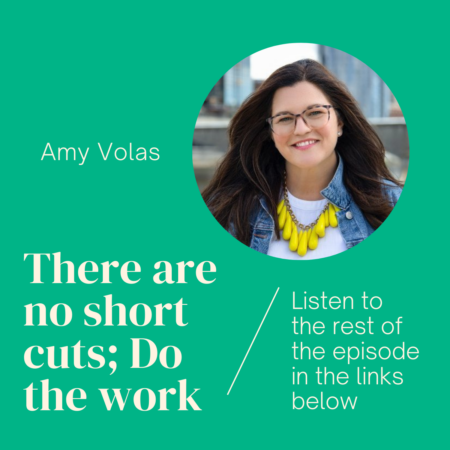
Hiring a VP of Sales for a Startup: Six Steps To Get This Right The First Time
Be honest, did your startup need to hire a VP of Sales six months ago?
If you’re a CEO or founder, you’ve probably been the unofficial VP of sales, sharing and selling your vision, for months or even years.
But if you’re finding success and still doing all the heavy lifting yourself or you’re managing a team of reps while leading the rest of the company, you may be stretching yourself too thin. This can leave you so far into the business that you can’t strategically think about it enough to really grow it.
Or maybe you’ve fallen into the trap so many Founders find themselves in where you’ve rushed to hire a VP of Sales in the past who ultimately didn’t work out. If you’re in this boat, you’re probably less than enthusiastic about going through all that stress again.
Believe me, I hear that.
Rushing this process will cost your startup money, resources, and headaches. It could also push your business back months or even years if you don’t get it right.
And no one has time for that… especially your startup.
So here’s the good news: I’m going to share everything you need to know about hiring a VP of Sales for your startup in today’s guide.
You’ll learn when it’s really the right time to hire a VP of Sales and find out the true cost of a bad hire. Then you’ll make your way through my proven six-step approach for hiring the best VP of Sales for your startup.
Use this intel to your advantage, and you’ll nail this process the first time and hit the ground running. You do want that, right?
Of course you do!
So let’s begin with the biggest question on the table:
When is the Right Time to Hire a VP of Sales for a Startup?
I know you’re here to learn how to hire a VP of sales for your startup. But first I have to ask, Are you sure this is the right time to do so?
Many startups and Founders I work with *think* it’s time to hire a VP of Sales. They hope doing so will take a huge load off their shoulders and bring in more revenue for their startup.
But that’s only true if the timing is right.
I discussed the finer points of hiring too soon versus too late in a guide I published on LinkedIn, so I’m only going to share the Cliffs Notes version here. (Check out the full article when you’re done reading this one to learn more!)
Duane and Donald summarize an important points that happen all too often when scaling startups:


What Happens When You Hire a VP of Sales Earlier Than You Need To
If your startup doesn’t have a steady stream of revenue and you hire a VP of Sales early on, it may:
Waste precious capital. A VP of Sales is NOT someone you hire to get your sales going. If they don’t have a seat at the table and you treat them like a glorified sales rep to do your dirty work, it will be the most expensive hire you make.
Consider this: the average salary of a VP of Sales for a startup begins around $185,000 and can climb over $250,000 when you factor in upside, equity, benefits, perks, bonuses, and more.
The average salesperson’s salary is a fraction of that. So you may be able to save your company a ton of money by getting another salesperson or two before investing in a VP of Sales.
Stall the growth of your sales team. A VP of Sales should help bring structure and efficient processes to the table whereas the day-to-day sales grind is better left to your salespeople. So if you’re having your VP carry a bag, your sales will actually stall instead of get better. As the saying goes, “if you’re too far in the business, you can’t think about the business.”
That’s why your expectations for your VP of Sales should be much higher. Sales is the heartbeat of your startup after all. Without sales you don’t have a business. A VP of Sales should be responsible for:
-
Working with Marketing to understand the best GTM (go to market) strategy
-
Understanding the post-sales buyer journey to understand which types of buyers are at the highest risk for churn
-
Understanding why revenue targets are missed and custom-crafts a plan to address the problem at the root
-
Creating a repeatable, measurable, scalable process to engage the buyer where they are versus where you want to force them to be
-
Recruiting and hiring the best salespeople to do the right work for your stage
-
Helping them scout, engage, and close better deals
-
Build, reinforce, and strengthen your culture
-
Scaling your sales team for growth
You can see that I didn’t mention going out and selling in those responsibilities. (By the way, I also don’t recommend hiring a player coach either since this can also backfire big time even though many people *think* it’s a good idea that will save them.)
So if you’re hiring this person to make sales calls while trying to lead a team at the same time instead of strategically growing your business, it’s not going to work out so well.
Keep in mind, just because hiring too early isn’t suggested doesn’t mean you should wait until it’s too late either.
Hiring Too Late Won’t Help This Problem Either
It’s not always a safe bet to wait out hiring a VP of Sales for your startup.
I often see Founders try to run their sales team entirely on their own. And hey, I get it. You know your product better than anyone, right?
What you may not realize, however, is how much you’re giving up to grind away at sales (or how much time it really consumes).
Case in point: I recently worked with a Founder that’s been doing the heavy lifting (like most do) for their enterprise deals and bigger opportunities. The problem was he was doing this in addition to leading his startup and managing a sales team of 10 and his customer service team.
He admitted on a call that he knew he needed help, especially because he would have great meetings and then things would slip through the cracks shortly after, losing all of the positive momentum he had gained.
This hurt him in a few ways — for starters, you only get one shot in enterprise deals, as you probably already know, and that door will likely never reopen again if the first meeting doesn’t go well.
Second, think about the example that sets for the team.
If it’s okay to let big deals fall through the cracks, then the smaller stuff should be okay too, right?
The obvious answer is no but this ends up happening all the time.
On top of that, think about the buyer journey this situation created — how likely would someone be to convert if this is how they’re treated? They won’t.
This is a prime example of being too far in the business to be able to think clearly about the business.
In reality, running your sales team will pull you away from crucial aspects of your business, such as innovating, improving, and raising money with the right partners, that only you can do.
Stretching yourself too thin to accomplish everything makes you less likely to succeed at anything.
So now you’re not only wasting time running sales (when it’s not your forte to begin with), but you’re also letting your product suffer and losing market ground.
Again, it’s not you; it’s just the reality of the situation.
But guess what? Your competitors are probably not running the show like this.
If they have a dedicated sales team and a VP of Sales, their founders can focus all their high-level attention on the product.
Imagine where you’d be in the next weeks and months if you had that opportunity. I bet you’d be lightyears ahead of where you are now.
Bringing in an expert who can successfully do the VP of Sales job so you can do yours is a win-win for everyone.
Now you’re probably thinking: Okay, great. Don’t hire too early or too late, got it. So when will I know the right time?
The Right Time to Hire a VP of Sales for a Startup
These five signs point to the right time to hire a VP of sales for your startup:
- It’s bigger than you. If you’re a Founder, you have a plethora of competing priorities. If you’re leading the sales team and notice important details like hiring, onboarding, process, deal management, coaching, and strategy slipping through the cracks, it’s a great signal to bring in a VP of Sales.
- You know your market and have a well-defined value proposition. If this is something you’re still trying to figure out, you’re setting up your startup and your VP of Sales for failure… wasting a lot of money and priceless time while making zero headway.
- You have sales reps in place, repeatable revenue, and a process to back it up Your small sales team should already be in place and bringing in revenue. Your VP of Sales should be able to step in, hone and refine the process, embrace hiring and onboarding, and lead the team to realize sustainable, repeatable results.
- You’re ready to make the investment to scale. Having at least $1M in ARR is a good benchmark to consider when it comes to making significant investments, like hiring a VP of Sales.
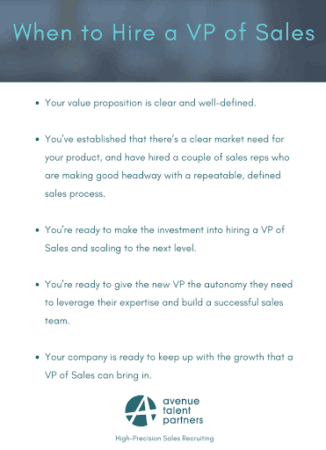
- You’re ready to give your new VP of Sales autonomy to build. The number one request on the “must have” list we receive from VPs in our hiring process is to truly have a seat at the executive table. Founders, you must be comfortable letting go of the reins so this key person can leverage their expertise to strengthen and scale your startup.
- Your startup is prepared to jump to the next level. This is where perception versus reality is table stakes. Your startup must be in a position to scale. If your VP of Sales does their job well, you will be rolling in sales while seeing major growth. Are you ready for the influx?
Look for repeatability within your business today to help you determine the best time to hire your VP of Sales. If you’re relying upon hope versus key business milestones, it’s best to work on your sales team and your process first.
After all, the last thing you want to do is make a mistake here (especially when you learn what that will cost you).
Pro tip: be realistic with where your startup is today and the near future. The lion’s share of Founders I speak to that reel from the nasty effects of a mishire, are those that hired for who they thought they’d be in the future versus what they needed at their current stage. Remember, there are over 48 different kinds of VPs of Sales in tech, make darn sure you hire for where your startup is:
The Costs of Hiring a VP of Sales Who Doesn’t Work Out
In this guide on the cost of a bad hire, I shared a pretty alarming stat discovered by Jason Lemkin:
“70% of Saas First VP Sales don’t make it to 12 Months. It’s one of the most common, and also most devastating mishires in startups.”
Welp.
Imagine paying a year’s salary and the expense of having the wrong person in seat only to learn that you have to go right back to the drawing board and start the hiring process all over again.
Headache and salary aside, there’s even more money wasted before your mishire hits their first work anniversary.
According to Dr. Bradford Smart, startups could lose upwards of $500k in compensation, or anywhere from five to 27 times the amount of someone’s salary:
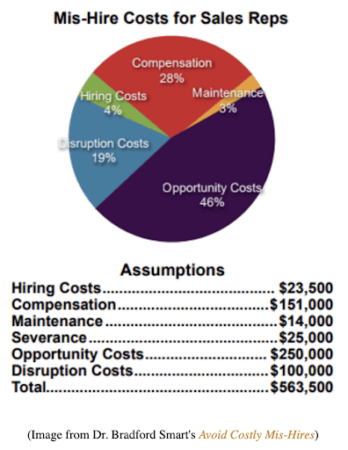
Need a minute to catch your breath?
While those numbers may be shocking, they’re not out of the ordinary. When you further break down those numbers, you’ll see the real costs of hiring the wrong VP of Sales include:

Now you see why it pays to get this right the first time around?
I thought you would.
So let’s say you have all your ducks in a row and all the right benchmarks mentioned earlier in place. What’s the game plan?
I’m so very glad you asked.
6 Steps to Successfully Hiring a VP of Sales for a Startup
You’re finally ready to hire a VP of Sales for your startup, kudos! Just follow these six steps to make sure you hire the best fit for your product, team, and future goals:
Step 1: Slow Down to Go Fast Later… Determine What You Need
Your first step is to figure out what you need your VP of Sales to do for your startup.
That starts by looking at what you already have in place.
Do you have one or two salespeople exceeding expectations, but working at max capacity? Do you need to hire more to follow suit?
Or do you have a large sales team that needs to sell more or work out the kinks of the sales process?
Or are you trying to tackle a new market altogether and need the right team and strategy to bring that plan to life?
The VP of Sales can do anything from strategy to process to recruiting and hiring to training and managing.
So it’s up to you to define exactly where your startup needs help most. You may need a leg-up in all of these areas or just a select few.
Whatever the case may be, specificity is your friend. This allows you to craft a job ad that piques the interest of someone who not only checks these boxes, but is eager to accept the challenge.
The power of a journal is an excellent way to make sure you don’t leave the mission-critical details behind. Jot your thoughts down on where this person is needed most before moving on to the next step.
Step 2: Decide What a Good VP of Sales Looks Like For YOUR Startup
I can’t emphasize this enough. This is the biggest area where Founders get it wrong and chase the shiny objects that are irrelevant to their task at hand. On top of figuring out why it’s time to hire, you must hone in on where you need help, while pinpointing the ideal qualities that would make someone successful in this position and with your team.
The best way to do that is to create a hiring scorecard, which I talked about in great detail in that article I just linked.
To summarize, this effective tool arms you with an unbiased system to evaluate candidates based on the same standards and qualifications you’re looking for to ensure alignment on the things that matter to your startup.
It helps you narrow down candidates who fit the bill while weeding out those who fall short. With a clear picture as to what and why, drastically reducing your margin for hiring error.
In building your hiring scorecard, you’ll gain clarity to figure out exactly what you’re looking for and what will make someone a perfect fit for your needs. Remember, when you’re clear, everyone else around you is clear. And when you’re confused, well, how on earth can anyone else around you be clear?
Clarity is no joke and it’ll take some work on your part to build your hiring scorecard.
I promise, the payout is worth it. Talk about some serious social proof from one of our most recent clients. They had a flimsy hiring process before we worked together and had never used a scorecard before:
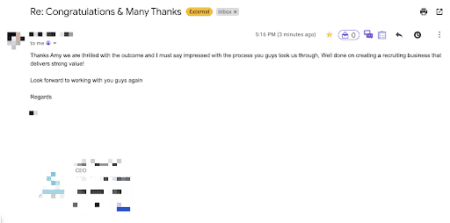
Imagine getting this hire right the first time and catapulting your startup to the next level because you did so.
You’re imagining yourself feeling pretty awesome, right?
Because you will be.
So here’s a peek at some of the questions you’ll be answering as you create your hiring scorecard:
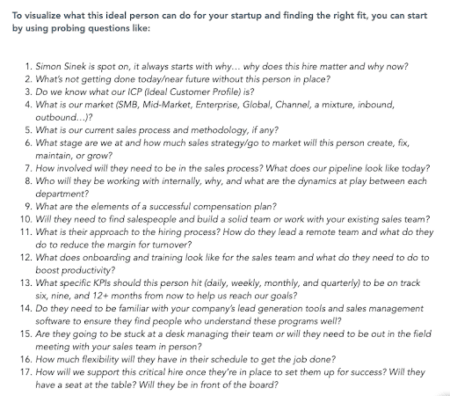
You’ll also want to think about must-have and must-avoid traits that this person should possess.
Answers to these questions can help you uncover your must-haves:
- Do you want someone who’s already comfortable leading sales teams, or would you be okay with this being someone’s first time doing so?
- How much experience do you want them to have at this level?
- Do you want someone who’s worked within startups before? If they have prior experience, what stage was that startup in?
Feel free to bounce around other questions with your team to determine your specific must-haves.
Answering the next questions can help you narrow down your absolutely-nots, or traits you don’t want your new hire to have. Someone with these traits may hurt your ability to grow and thrive as a company:
- Do you want a VP of Sales from a big, established brand who may be good with steady growth, but doesn’t know how to build or is unable to figure it out?
- Do you believe there’s a minimum amount of experience required so you don’t have to hold their hand?
- Are there some preferences, such as being unwilling to work in the office or travel, that just don’t jive well with your team?
If you’re having a hard time coming up with a list of absolutely-nots, just think about all the mishires you’ve encountered before. What irked you or caused issues?
When you put this into a real-world perspective based on your company’s history, you’ll have less trouble ID’ing potential bad apples.
So once you determine these traits and answer those questions, you can build out your hiring scorecard with confidence.
In that guide, you’ll find the exact hiring scorecard I use, which will give you inspiration and direction for how to create yours.
You can then take everything you outlined in your hiring scorecard to build out the perfect job ad.
Step 3: Create a Detailed Job Description
Crafting a job description will be much easier after you create your hiring scorecard. That should contain all the traits, qualifications, and experience you’re looking for, and so should your job description.
To create a job description that lures in the best candidates:
- Be transparent about your company needs and who will be successful in this role. Cut it with jargon and platitudes, this is not the time to sugarcoat things and paint a picture of a well-oiled machine if that’s not what you have.
So get transparent about what you need this person to do and describe your situation in detail — the good, the bad, and the challenges you’re facing. This ensures only the most qualified candidates have a clear understanding of what you need, want, and why. This automatically sets you apart from the rest.
The goal here is to describe:
- What your current situation looks like
- Your future goals
- Your new hire’s responsibilities and your expectations
- The skills/qualifications/experience your ideal candidate possesses
- How you’ll define success in this role in 3 months, 6 months, 1 year, etc.
Pro tip: if hiring more women is important to you, this free gender decoder tool has your name written all over it. Words matter, job descriptions are no exception to the rule.
- Suss out and clearly articulate your startup’s story, mission, values, and company culture. Alignment is everything. Your best hire should be aligned with these in practice, not theory. Otherwise, you run a big risk of living the statistic so many Founders face to lose this key hire within the first 18 months.
Include specific details about how your employees embody your startup’s unique culture while giving them a front row seat at what it’s really like to work with you and the team. How are you really managing working in-house, remotely, or a hybrid mix of both?
From there, move on to:
Step 4: Use a Hiring Scorecard to Make a Confident Decision
It’s time to put your scorecard to use once again! This time, you’ll use it during every interview to evaluate each candidate in an unbiased way within 24 hours of each interview.
Instead of being seduced by a smooth talker, for example, you’ll be taking the guesswork out of the equation to accurately gauge whether someone will be a good fit for the needs of your startup.
It’s just like the Olympics — sans sparkly leotards and patriotic uniforms.
As you work through the interview process, you’ll be able to effectively rate each candidate on a scale of one to ten in each category that’s important to your startup. At the conclusion of the process, you’ll have an easy way to clearly make a hiring decision.
Check out this guide on how to use your hiring scorecard effectively when you’re done here!
Step 5: Test the Waters
It’s a smart idea to let your first-choice candidates spend some time with your team before you pull the trigger and offer them the position.
I’m not suggesting that you carve out a full day of work for these potential hires.
But taking a page out of the “Real World Playbook” to see what happens when you stop being polite and start getting real to get as close to what it’s really like to work together is a lifesaver… for both parties involved.
Some ideas to do this well:
Have candidates attend a brainstorming session. Your potential hire will get a better feel for how the team interacts and works together. If they feel comfortable, encourage them to share their ideas or even illustrate their approach. This should give your team a taste of what may come if you hire them.
Invite your top choice candidates to meet with the board.
Allow candidates to see where your bodies are buried. Share your real challenges, data, obstacles, and failures. It’s a “sweaty palms” moment, but people crave understanding the reality of your startup and what they’re really walking into. It also reinforces your leadership when you can shoot a person straight to get to the brass tacks together of the task at hand… talk about showcasing your ability to walk your talk as a Founder to give them a seat at the table?!
Step 6: Make the Hire and Set Them Up For Success
Time kills deals as they say in sales. Hiring is no exception to this rule. When you interview someone that scores well, has the ability, desire, and is leaning into the process, HIRE THEM. Embracing an abundance versus scarcity mindset in the hiring motion is your best friend and secret weapon to scale your startup with the right team, doing the right work, in the right roles.
That last part doesn’t come naturally for many Founders, and many startups mess this up more times than not.
To put your new hire in a position to succeed, you need to create an onboarding experience that goes above and beyond. And that means rolling out the red carpet. One of my favorite ways to think about this is the experience you’d get at the Four Seasons concierge versus the check in counter at the Motel 6… strive to be the Four Seasons.
Show them how much you value them and respect their abilities. That you heard them and are setting them up for success. This is the time to back up your words with actions to create a plan where they can make a significant impact on your startup and how excited you are to achieve that with them.
To make your onboarding experience flow smoothly:
Make sure all of the technology and equipment they need to be successful is ordered ahead of time to have set up and ready to go for the first day. Make sure they have access to Slack, your CRM, drives, security clearance, email, etc. and they’re ready to go.
Have your documents ready to go ahead of time. There’s nothing worse than wasting that first day of excitement filling out a mountain of paperwork.
Make your new hire feel welcome. Have an agenda for week one and include other executive and team members they’ll be working with before they start. We recently had a client have a custom illustration made and sent the week before he started… talk about making an indelible impression to make the person feel warm, fuzzy, and welcome!
You’ll build a solid relationship from the start, making it more likely to retain them for the long haul.
Give them the lay of the land. Policies, expense accounts, in-office expectations, team welcome, travel, tools, process, how meeting agendas get communicated, who is responsible for what, an executive welcome wagon, etc., tour of the office layout, the tools you use, your sales process, a typical meeting agenda, etc. Once they have an idea of what they’re getting into and how it works in real life, they’ll be more excited to jump in and hit the ground running.
Final Thoughts On Hiring a VP of Sales for a Startup
If you’ve made it to this point, you’re already ahead of the pack, and now have everything you need to hire a VP of Sales for your startup. More importantly, you know how to do this right the first time.
Rather than hiring too early or too late, you’ll be one of the very few startups that know when you’re in the sweet spot. You also have a scorecard to help evaluate and choose the right person for the job instead of falling for a shiny object that doesn’t live up to the hype.
Follow the tips and steps in this guide, and you’ll hire a VP of Sales who fits with your startup, exceeds expectations, and sticks around beyond the next milestone.
I know it’s possible because I’ve seen it firsthand with my clients. And I can’t wait to see the process work for your startup too!
